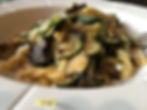- njneeck
- Aug 19
- 2 min read
Fiori di zucca, aka squash flowers, are the edible blossoms of the zucchini plant. From what I've seen they’re enjoying a surge in popularity at farmers’ markets, and tis the season. This recipe brings back cherished memories of eating them for the first time in Rome many years ago, stuffed Roman-style with anchovies and mozzarella. Recently my daughter Alessa and I made them at at food and wine pairing class we co-taught, and they were a HUGE hit! Yes, a bit of work that requires some TLC, but after the first bite no one expressed reservations! Follow Alessa and check out her video post at corkecucina on Instagram.



Here's the recipe. You can also find it in my book, Cooking by Heart, Recipes from Nella's Kitchen (link on home page.)
STUFFED ZUCCHINI BLOSSOMS with MOZZARELLA & ANCHOVY
1 ¼ cups all-purpose flour
2 tablespoons extra-virgin olive oil
2 large egg whites
12 large zucchini blossoms
Block of mozzarella cheese
12 flat fillet anchovies packed in olive oil, rinsed and patted dry
Peanut or vegetable oil for frying
Salt
To make the pastella (batter), whisk the flour, oil, a pinch of salt, and 1 cup cold water together to a smooth, thick consistency. Refrigerate for at least one hour. Before frying, in a clean bowl beat the egg whites to stiff peaks, then gently fold into the batter.
Meanwhile, carefully remove the stamen from inside the blossoms and gently rinse out any pollen. Place the cleaned blossoms on paper towels to absorb as much excess moisture as possible. Cut mozzarella into 12 1 1/4-inch long x 1/2-inch wide batons. Place one piece each of mozzarella and anchovy inside each blossom. Gently twist the blossoms to hold them closed, as best you can.
Pour oil to a depth of about 2 inches into a wok or straight sided pan and heat on medium to 375 degrees, until a bit of batter dropped into the oil sizzles immediately on contact. Drag the blossoms, a few at time, through the prepared batter to coat generously and evenly, then immediately and carefully place them in the oil; don’t crowd the pan. (You probably won't use all the pastella.) Repeat with the remaining stuffed blossoms. Fry until puffed, crisp and golden brown on all sides. Using a slotted spoon or tongs, transfer the fried blossoms to a paper towel lined platter. Sprinkle lightly with salt, serve immediately.








